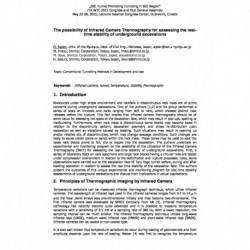Cart
0
0
No document
0,00 €
Total
Document successfully added to your shopping cart
Quantity
Total
There are 0 items in your cart.
There is 1 item in your cart.
Total documents
Total shipping
To be determined
Total
Search & filter
Search for a publication
Search & filter
The possibility of Infrared Camera Thermography for assessing the real time stability of underground excavations
irct_tarutoge_wtc2015_fp_ms_oa
Ö. Aydan / M. Imazu / M. Soya / H. Ideura
Rockbursts under high stress environment and rockfalls in discontinuous rock mass are of prime concerns during underground excavations. One of the authors [1,2] and his group performed a series of tests on minerals and rocks ranging from soft to hard, which showed distinct heat releases before the rupture. This fact implies that infrared camera thermography should be of some value for assessing hot spots at the excavation face, which may result in pop-ups, spalling or rockbursting. Furthermore, when rock mass is discontinuous some blocks may become loose in relation to the discontinuity pattern, excavation geometry and stress re-distribution upon excavation as well as vibrations caused by blasting. Such situations may result in opening up and/or relative slip of discontinuities, which may change seepage conditions. Such changes are likely to cause colder zones or bands within the rock mass. These zones may be used to spot the loose rock blocks prone to fall, slip or topple into the excavation. The authors undertook an experimental and monitoring program on the possibility of the utilization of the Infrared Camera Thermography (IRCT) for assessing the real-time stability of underground excavations. First, a series of laboratory tests on rock specimens and large rock blocks having a circular hole are tested under compression environment in relation to the deformation and rupture processes. Later, some observations were carried out at the excavation face of Taru-Toge tunnel before, during and after blasting operation in relation to assess the real-time stability of the excavation face. The authors present the outcomes of this unique experimental and monitoring program for real-time stability assessments of underground excavations and discuss their implications in actual applications. Temperature variations can be measured infrared thermograph technique, which utilize infrared cameras. The wavelength of infrared rays used in the infrared cameras ranges from 0.7 to 14m and the focal plane arrays was one-dimensional initially and they become two-dimensional. The first infrared camera was developed by SPATE Company from UK [3]. Infrared thermography technology has recently become quite advanced and it is possible to measure temperature variations with a sensitivity of 0.1 mK at a sampling rate of 380 Hz. With a lower resolution, the sampling interval can be much smaller. The infrared thermography technique utilizes long-wave infrared rays (LWIR), medium wave infrared rays (MWIR) and short-wave infrared rays (SWIR). Infrared cameras can be cooled or non-cooled type. It is also well known that temperature variations do occur during loading of geomaterials and their amplitude depends upon the rate of loading. Weber [4] was first to recognize the temperature




